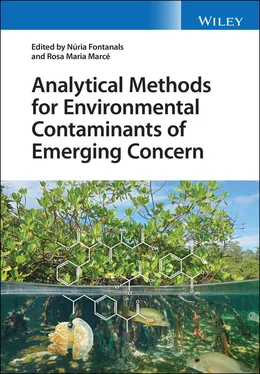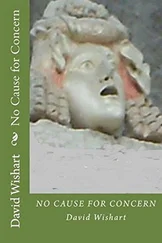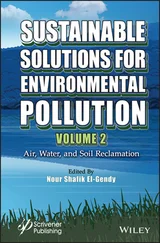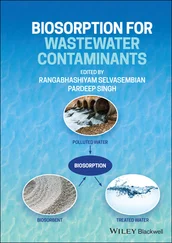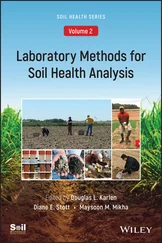Analytical Methods for Environmental Contaminants of Emerging Concern
Здесь есть возможность читать онлайн «Analytical Methods for Environmental Contaminants of Emerging Concern» — ознакомительный отрывок электронной книги совершенно бесплатно, а после прочтения отрывка купить полную версию. В некоторых случаях можно слушать аудио, скачать через торрент в формате fb2 и присутствует краткое содержание. Жанр: unrecognised, на английском языке. Описание произведения, (предисловие) а так же отзывы посетителей доступны на портале библиотеки ЛибКат.
- Название:Analytical Methods for Environmental Contaminants of Emerging Concern
- Автор:
- Жанр:
- Год:неизвестен
- ISBN:нет данных
- Рейтинг книги:5 / 5. Голосов: 1
-
Избранное:Добавить в избранное
- Отзывы:
-
Ваша оценка:
- 100
- 1
- 2
- 3
- 4
- 5
Analytical Methods for Environmental Contaminants of Emerging Concern: краткое содержание, описание и аннотация
Предлагаем к чтению аннотацию, описание, краткое содержание или предисловие (зависит от того, что написал сам автор книги «Analytical Methods for Environmental Contaminants of Emerging Concern»). Если вы не нашли необходимую информацию о книге — напишите в комментариях, мы постараемся отыскать её.
Provides the analytical methodology required to detect different families of organic compounds of emerging concern (CECs) from environmental samples Analytical Methods for Environmental Contaminants of Emerging Concern
Analytical Methods for Environmental Contaminants of Emerging Concern
Analytical Methods for Environmental Contaminants of Emerging Concern — читать онлайн ознакомительный отрывок
Ниже представлен текст книги, разбитый по страницам. Система сохранения места последней прочитанной страницы, позволяет с удобством читать онлайн бесплатно книгу «Analytical Methods for Environmental Contaminants of Emerging Concern», без необходимости каждый раз заново искать на чём Вы остановились. Поставьте закладку, и сможете в любой момент перейти на страницу, на которой закончили чтение.
Интервал:
Закладка:
Eva Pocurull Department of Analytical Chemistry and Organic Chemistry Universitat Rovira i Virgili Tarragona, Spain
Cristina Postigo Department of Environmental Chemistry Institute of Environmental Assessment and Water Research (IDAEA)-CSIC Barcelona, Spain
Roberto Romero González Department of Chemistry and Physics University of Almeria Almeria, Spain
Noelia Salgueiro-González Department of Environmental Health Science Istituto di Ricerche Farmacologiche Mario Negri – IRCCS Milan, Italy
Juan Luis Santos Departamento de Química Analítica Escuela Politécnica Superior Universidad de Sevilla Sevilla, Spain
Piotr Stepnowski Department of Environmental Analysis University of Gdansk Gdansk, Poland
Nikolaos S. Thomaidis Department of Chemistry National and Kapodistrian University of Athens Athens, Greece
Konstatinos Vasilatos Department of Chemistry National and Kapodistrian University of Athens Athens, Greece
Ettore Zuccato Department of Environmental Health Science Istituto di Ricerche Farmacologiche Mario Negri – IRCCS Milan, Italy
Preface
The occurrence of organic compounds of emerging concern (CECs) in the environment has given rise to growing unease. Although most CECs have been present in the environment for years, some of them have only recently been identified. Thus, some of these compounds remain unregulated and their toxicity and risk unstudied. They occur in different environmental compartments at trace levels (low ppb or ppt). Moreover, CECs belong to different families with several origins and have a broad range of physical-chemical properties. To respond to this situation, sensitive and selective analytical methods have been developed to determine different types of CECs in a broad range of environmental samples. Most of these analytical methods comprise sample preparation followed by chromatographic separation coupled to mass spectrometry. The specific requirements at each step of the analytical method are linked to the properties of the contaminants and sample matrix.
The aim of this book was to compile the analytical methods available to determine CECs in environmental samples. It is organized by families of CECs, with each chapter presenting complete information for each family. The chapters are dedicated to the following families of CECs: pesticides ( Chapter 1); pharmaceuticals ( Chapter 2); personal care products ( Chapter 3); novel psychoactive substances ( Chapter 4); artificial sweeteners ( Chapter 5); perfluorinated substances ( Chapter 6); high production volume chemicals ( Chapter 7); musk fragrances ( Chapter 8); disinfection byproducts ( Chapter 9); and microplastics ( Chapter 10). The relevant environmental samples are covered in each chapter (i.e., family of CECs): different types of water (drinking, tap, surface, and sewage), solids (sediment, soil, sludge, dust, as well as biota), and atmospheric samples (air and particulate matter). With a few exceptions, the content of each chapter is organized into the same sections – an overview, sample preparation and collection, determination, and future directions. In each chapter, different analytical methods are proposed through examples of cutting-edge research studies that are summarized in the form of tables to provide an overview of the state of the art; however, the common methods currently employed are also described so that the reader can identify the methods typically used. Thus, this book provides a detailed description of the different approaches for determining each group of CECs in environmental samples with distinctive, critical information about the state of the art for their determination in the environment. The editors truly hope that this book will serve to help researchers, industrial experts, students, decision-makers, and interested members of society learn about the approaches available to monitor each family of CECs, covering most of the CECs occurring in the environment.
We would like to acknowledge the authors for their invaluable contributions. All of the authors of this book are experts and skilled professionals in environmental trace analysis and, in particular, in each of the families of CECs addressed in each specific chapter. Without their effort and dedication, this book would have not been possible. We also sincerely thank our readers for their interest in this book. Thanks for reading and we hope you enjoy it!Núria Fontanals and Rosa Maria Marcé
October 2021
1 Pesticides
Irene Domínguez, Rosalía López Ruiz, Antonia Garrido Frenich, and Roberto Romero González
Department of Chemistry and Physics, Andalusian Center for the Assessment and Monitoring of GlobalChange (CAESCG), University of Almeria, Agrifood Campus of International Excellence, Almeria, Spain
1.1 Overview of Pesticides
There are thousands of chemicals that can enter the environment and pesticides are among the most significant. They have been used in the last decades in several areas, but agricultural activity is the main source of the impact of pesticides in the environment and therefore they can be present in soil, water, crops as well as in the atmosphere [1].
1.1.1 Properties
Pesticides are a class of chemicals used to limit, inhibit or prevent the growth of harmful animals, insects, weeds or fungi [2]. They can be classified according to different criteria, such as target organism, origin or chemical structure, but the most common is considering the target organism, being herbicides, fungicides, insecticides, etc., among others [3]. There are more than 800 active components and they are available in different accessible products [4]. Despite the benefits of the use of these compounds, they can be toxic to humans and many of them have been classified as endocrine disruptors, and carcinogenic effects have also been reported [5].
The widespread use of pesticides in combination with their physico-chemical properties, such as water solubility, octanol/water partition coefficient, volatility and stability against degradation by abiotic and biotic factors, are the reasons for their distribution and occurrence in different environmental matrices such as water, soil, air and biota [6] by physical processes as sedimentation leaching, sorption and volatilization.
Once pesticides are in the environment, they can be transformed by biotic or abiotic process [7], increasing the number of potential transformation products (TPs) that can be detected, and most of them are still unknown [8]. In this sense, TPs could also have environmental concern and so in addition to the parent compounds they should also be monitored in order to get a comprehensive overview of the environmental fate of pesticides.
1.1.2 Legislation
The presence of these pollutants poses a potential risk for the environment and human health and, therefore, international organizations have set legal limits regarding the presence of pesticides in water and other environmental matrices, for controlling and preventing contamination of environmental ecosystems.
For instance, in Europe, the Water Framework Directive (WFD) is intended to protect transitional waters, inland surface waters, coastal waters and groundwater. Strategies against the chemical pollution of surface waters led to the Directive 2008/105/EC [9], establishing concentration limits of 33 priority substances and 8 other pollutants, including some pesticides such as simazine and trifluralin. Priority substances are considered to pose a significant risk to or via the aquatic environment, so environmental quality standards (EQSs) were set for each of them. Then, amending Directive 2013/39/EU [10] introduced 12 new compounds to the list and the need to establish an additional list of potential water pollutants (Watch List) that should be carefully monitored to support future reviews of the priority substances list. Currently, among the priority substances are 24 pesticides with Annual Average EQS (AA-EQS) values ranging from 1 × 10 −8µg l −1for heptachlor and heptachlor epoxide to 1 µg l −1for simazine. In 2020, the European Union (EU) established a new Watch List of substances, including azole compounds and providing maximum acceptable method detection limits for them from 29 to 199 ng l −1[11]. Additionally, the Drinking Water Directive 98/83/EC, amended by EU 2015/1787 [12], set special quality requirements for water for human consumption. It set concentration limits for a range of hazardous substances, including pesticides, establishing a general maximum individual concentration of 0.1 µg l −1for individual pesticides (0.030 µg l −1in the case of aldrin, dieldrin, heptachlor and heptachlor epoxide) and 0.5 µg l −1for the sum of all individual pesticides and relevant metabolites/TPs detected. The same values, 0.1 and 0.5 µg l −1, for individual and total pesticides respectively, are established as groundwater quality standards in Directive 2006/118/EC [13] on the protection of groundwater against pollution and deterioration.
Читать дальшеИнтервал:
Закладка:
Похожие книги на «Analytical Methods for Environmental Contaminants of Emerging Concern»
Представляем Вашему вниманию похожие книги на «Analytical Methods for Environmental Contaminants of Emerging Concern» списком для выбора. Мы отобрали схожую по названию и смыслу литературу в надежде предоставить читателям больше вариантов отыскать новые, интересные, ещё непрочитанные произведения.
Обсуждение, отзывы о книге «Analytical Methods for Environmental Contaminants of Emerging Concern» и просто собственные мнения читателей. Оставьте ваши комментарии, напишите, что Вы думаете о произведении, его смысле или главных героях. Укажите что конкретно понравилось, а что нет, и почему Вы так считаете.
